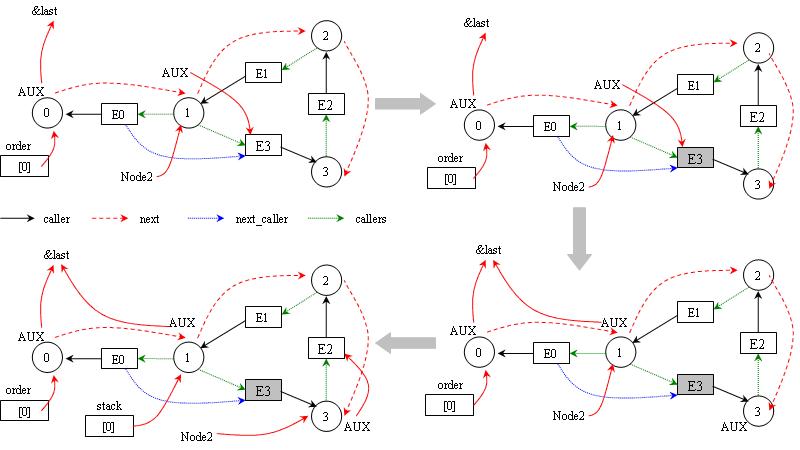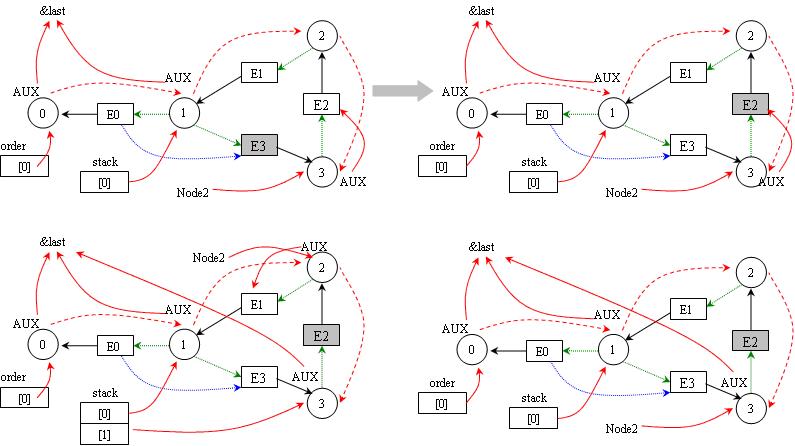5.13.5.3.2.2.1.
Sort by invocation order
Out of aiding below processing, at line 1253, put all cgraph_node in
the order of invocation, and transform the direct graph into queue (it
satisfies the definition of topological order).
548
static
int
549
cgraph_postorder
(struct
cgraph_node **order)
in cgraphunit.c
550
{
551
struct
cgraph_node
*node, *node2;
552
int stack_size = 0;
553
int order_pos = 0;
554
struct
cgraph_edge *edge, last;
555
556
struct
cgraph_node **stack =
557
xcalloc (cgraph_n_nodes
,
sizeof
(struct
cgraph_node *));
558
559
/* We have to deal with cycles nicely, so use
a depth first traversal
560
output algorithm. Ignore the fact that some
functions won't need
561
to be output and put them into order as well,
so we get dependencies
562
right through intline functions.
*/
563
for
(node = cgraph_nodes
; node; node =
node->next)
564
node->aux = NULL;
565
for
(node = cgraph_nodes
; node; node =
node->next)
566
if (!node->aux)
567
{
568
node2 = node;
569
if (!node->callers)
570
node->aux = &last;
571
else
572
node->aux = node->callers;
573
while
(node2)
574
{
575
while
(node2->aux != &last)
576
{
577
edge = node2->aux;
578
if (edge->next_caller)
579
node2->aux = edge->next_caller;
580
else
581
node2->aux = &last;
582
if (!edge->caller->aux)
583
{
584
if
(!edge->caller->callers)
585
edge->caller->aux =
&last;
586
else
587
edge->caller->aux =
edge->caller->callers;
588
stack[stack_size++] = node2;
589
node2 = edge->caller;
590
break
;
591
}
592
}
593
if (node2->aux ==
&last)
594
{
595
order[order_pos++] = node2;
596
if (stack_size)
597
node2 = stack[--stack_size];
598
else
599
node2 = NULL;
600
}
601
}
602
}
603
free (stack);
604
return
order_pos;
605
}
Alogrithm used
here is that first proposed by Kahn in 1962, its detail is given below:
L ← Empty list that will contain the sorted elements
S ← Set of all nodes with no incoming edges
while S is non-empty do
remove a node n from S
insert n into L
for each
node m with an edge e
from n to m do
remove edge e from the graph
if
m has no other incoming edges then
insert m into S
if graph has edges then
output error message (graph has at least one cycle)
else
output message (proposed topologically sorted order: L)
However in here
implementation, cycle isn’t a problem (it caused by direct or indirect
recursion), as C++ program always begins with function main, when cycle
appears, it begins with the node most far away from main. No doubt, recursed
function can’t be inlined, or it will cause infinite expansion. But we don’t
treat it here.
Take below invocation
relation as example, we have known cgraph_node is built in its first time
invocation, so their order in cgraph_nodes
reflect the order of the time of
invocation. In below figures, the order of the time of invocation is: 0
->
1
->
2
->
3
->
1.

Figure 119
: handling node 0
As function 0 hasn’t
caller, clearly, it’s the first node after sorting.

Figure 120
: handling of node 1
Function 1 appears in a
cycle, thus its node’s AUX follows to next caller’s cgraph_edge.

Figure 121
: handling node 1
in second time
Treating function 1 again,
cache it into stack, and enter its next caller.

Figure 122
: handling of node 3
Step into call chain of
function 1, function 3 is still not the final caller, cache it into stack too.

Figure 123
:
handling of node 2
Function
2 at the head of the call chain of function 1, but it is also called by
function 1, howeverfunction 1 hasn’t been handled, so accept it as sorted node.

Figure 124
: handling of nodes in stack
Nodes in the stack then
are fetched in LIFO order and put into the sorted queue. The sorted queue
is:
0
->
2
->
3
->
1
。